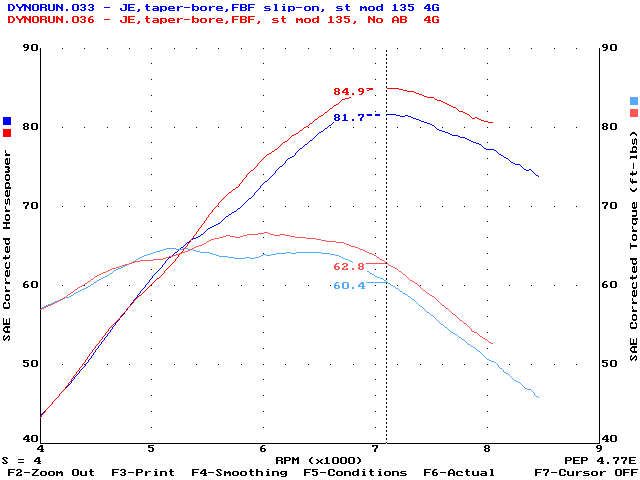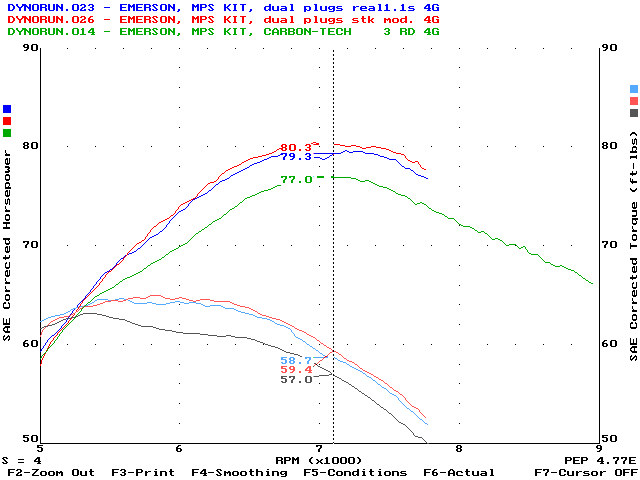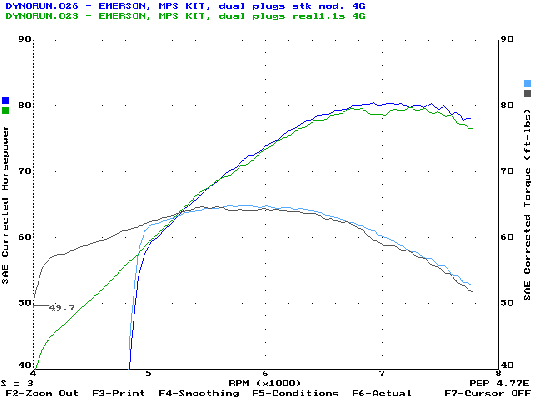
Last winter, I was machining several other sets of heads, so Burt brought his in to be done. I encouraged him to have other head work done at that time, but he wanted to know the results of dual plugging. Here was an opportunity to learn something.
Burt assembled the engine with the ignition timing 2 degrees retarded from stock, as a starting point. He was pleased with the way it ran this spring, and last Saturday (May 23rd) we put it on the dyno.
Since we already had dyno results from the previous configuration, comparisons should be valid. Only one problem; Burt had changed to an open airbox configuration, from stock top with the 'snorkels' removed.
I have dredged up the results of a previous report (Dave Hackney's HC/taper-bore tests) which shows the effects of stock top vs open air-box.

These are typical results of this conversion. The characteristic changes of the torque curve from the wavy stock one to the much smoother open air-box curve.
So, this is what one might expect from the airbox change. Now, let's take a look at the dyno chart of Burt's, before and after dual plugging.

You should be able to detect the difference in the curve characteristics from the air-box change. If that is taken away, there is little left over to be attributed to the dual plug conversion. But, maybe the ignition timing isn't retarded enough (it's supposed to require 10 degrees and we're only 2 degrees retarded.)
Proper proceedure would be to optimize the ignition timing for each set of conditions or changes, and, that's why we put it on the dyno anyway. I use Pederzini 1.1 modules to find if an engine likes 2 degrres retarded timing. It's quicker than draining the oil, removing the left side cover, and moving the ignition pick-ups.
If you find that the engine likes 2 degrees less advance, then you have to go in and change the pick-ups, probably by 4 degrees, so you can check 4 degrees less advance, then with the 1.1s, you can check 6 degrees. On real high compression engines, they seem to like as much as 6 degrees less. Feldman's 984, for instance.
Let me rant a little about the Pederzini ignition modules. There is a report about these, click herePederzini, but it appears that they are still mis-understood. The most important thing about the 1.1 modules is that they don't advance as much as stock. They may have a different advance point, but above 3000 RPM, they stay at an ignition timing which is 2 degrees less advanced than stock. For all of the WOT tests, that is the only difference.
The next chart shows the result of this 2 degree difference in timing.

As you can see, there was no increase in power from stock modules to 1.1s.
It can be said that there might be increases with less advance, but in previous testing, the greatest improvements occur when you are the farthest from the correct timing. As you get closer to the optimum, the difference is less. My conclusion is; the ignition timing requirement for Burt's bike is 2 or 3 degrees less than stock with dual plugs.